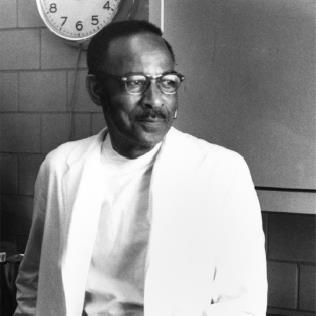Vivien Thomas

Vivien Thomas (1910-1985) overcame many challenges, including poverty, racism and the lack of a college education, to become a cardiac surgery pioneer who trained a generation of surgical residents in his Johns Hopkins surgical lab. Thomas is best known for his role in developing a groundbreaking surgical technique to correct a potentially fatal birth defect known as Tetralogy of Fallot, that resulted in oxygen-poor blood leaving the heart, which is also known as blue baby syndrome.
Thomas was a carpenter in Nashville, TN, in 1930 when he met Dr. Alfred Blalock, who is considered the father of modern cardiac surgery. Dr. Blalock hired Thomas as a laboratory assistant at Vanderbilt University, and together they worked to conduct a series of breakthrough experiments focused primarily on the treatment of hemorrhagic and traumatic shock, which evolved into the study of Crush syndrome. This work saved the lives of thousands of soldiers on the battlefields of World War II.
In 1941 Dr. Blalock took a job at his alma mater, Johns Hopkins, and brought Thomas along to continue their work. It’s instructive to note that Dr. Blalock was offered other jobs before his move to Johns Hopkins, and he did not consider taking any where the employer would not hire Thomas as well. It was at Johns Hopkins where Thomas learned the surgical technique to correct Tetralogy of Fallot, which he taught to Dr. Blalock. Thomas even created the surgical instruments to perform the operation.
The first blue baby surgery took place in November 1944, with Thomas standing on a stepstool to coach Blalock over his shoulder – a scene made famous in the movie about Thomas called Something the Lord Made and the PBS documentary titled Partners of the Heart. The successful procedure was covered worldwide and literally changed the course of medicine, although Thomas received no acknowledgement for his contributions.
In 1946, Thomas developed a surgical technique to improve blood circulation for patients whose aorta and pulmonary artery were transposed, a complex operation called an atrial septectomy. When Blalock inspected Thomas' completed procedure he reportedly said, "This looks like something the Lord made."
Thomas served as supervisor of surgical laboratories at Johns Hopkins for 35 years, training many leaders in the emerging field of cardiovascular surgery. He was awarded an honorary doctorate by Johns Hopkins in 1976 for his many contributions, the same year the Johns Hopkins School of Medicine appointed Thomas to its faculty as an instructor of surgery.
Read all our Black History Month profiles.

